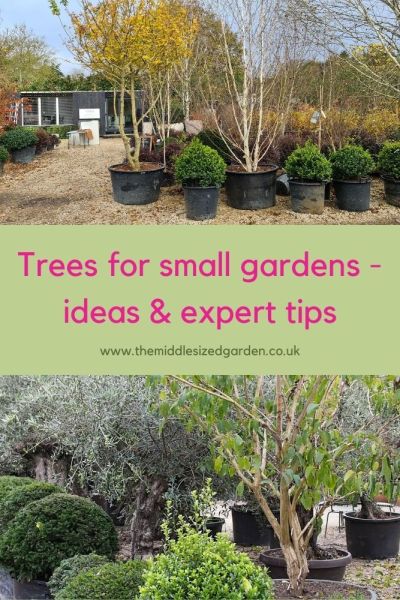Best trees for small gardens – expert advice and new ideas
When you’re choosing trees for small gardens, always try to find out what they will look like in 5-10 years time.
That’s advice from Jamie Butterworth, award-winning garden designer, RHS ambassador and MD of tree and shrub specialist Form Plants. As a garden designer and a professional tree grower, he’s chosen and grown trees for every space from a tiny balcony to a thousand-acre estate.

Jamie Butterworth, garden designer, MD of Form Plants, RHS ambassador and author of 50 Plants You Can’t Kill.
But buying a tree for a small garden doesn’t always mean buying a small tree. Jamie also has tips for restricting the height and size of many trees.
And you can grow any tree in a pot, which is another way of keeping it small.
Form Plants grow trees, shrubs, topiary and perennials for garden designers and landscapers. They also have public open days, and they’re next door to the plant nursery Crocus in Dorney Court, Berkshire. People often wander over from Crocus to look at Form Plants’ trees and shrubs as well.
If you prefer to watch on video, the full interview on choosing trees is here.
Jamie’s tips for trees for small gardens
- Check the ultimate height and how long it takes to grow
- Check what the tree has to offer in all four seasons
- What are the soil conditions and how much sunlight will your tree get?
- You can grow any tree in a pot for small gardens, balconies and courtyards. That will restrict its growth
- You can also control the shape and size with pruning, depending on the tree.
- Try pollarding (cutting all the branches from the crown once a year)
- Or pleaching (training against a square, free-standing frame)
- Or espaliered trees – fruit trees trained against a frame or wall
- ‘Table top’ trees are trained on a frame to look like a table top.
- Topiarise trees to keep them smaller
- Coppiced and multi-stemmed trees are smaller than single trunk equivalents
- If you already have a tree, but it’s too big, consider pruning it into shape rather than cutting it down
Check what the tree has to offer in all four seasons
Every inch counts in a smaller garden, so pick a tree that looks good in more than one season.
For example, the Strawberry tree (Arbutus unedo) is evergreen, so it will give you a year round green presence. And it also has both fruit and flowers in the autumn, with strawberry-like fruits and creamy white or pink flowers. It reaches 4m-8m high so would fit in most gardens and can also be grown in a large pot.
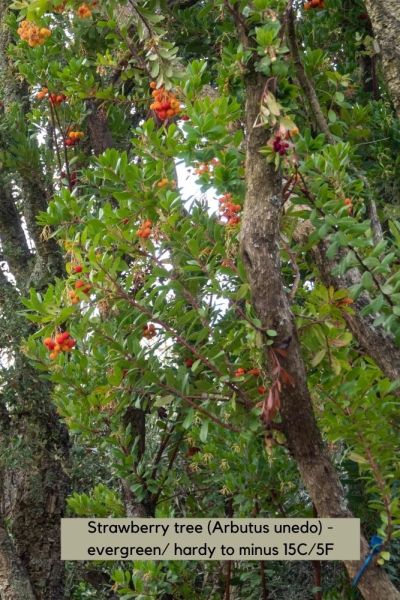
This evergreen Strawberry tree growing at Form Plants has both autumn flowers and fruit, so it’s very wildlife friendly. Grows 4m-8m high.
If you don’t know what your soil is like, do a soil test. And think about whether the tree will be in sun or shade.
Even if a tree will grow in both sun and shade, it may grow differently in each. In this post, you can see how planting the same kind of tree just a few metres apart can dramatically change the autumn colour.
Jamie recommends the Barcham Trees Tree Finder service. You can put in detail about the type of tree you’re looking for – height, shape and more. The website will give you a shortlist of trees.
There’s more advice on choosing the right tree for your garden here.
You can grow any tree in a pot to keep it small
All the trees at Form Plants are grown in pots. Some reach a good height. But they will never get as tall as they would if they were growing in the ground. (Once they’re planted in the ground, they’ll grow normally.)
So growing trees in pots can be a good option if you move frequently or if you want to restrict the height of a big tree, such as an oak or a beech.
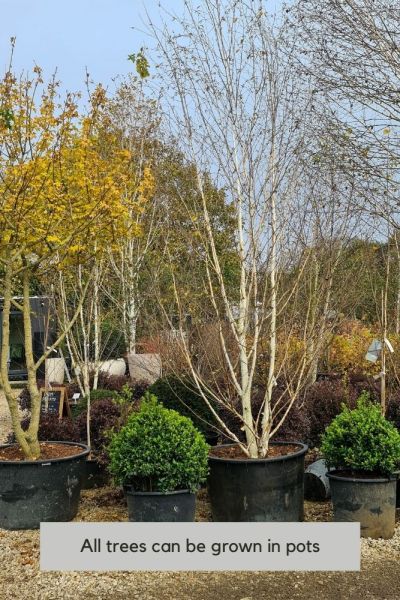
You can grow the largest trees in the smallest gardens if you restrict their height by growing them in pots. But you will have to water and fertilise them, especially in the summer.
But it can be very difficult to repot a huge tree. At Form Plants they use a system called Airpot. It’s a system made of recycled plastic, which you can essentially wrap around the rootball. Tiny little holes stimulate root growth.
When the plant or tree grows too big for the size of the container, you can unwrap it and re-use the Airpot for another plant. Then you can wrap the larger size around the plant. There is more explanation on the Airpot company website.
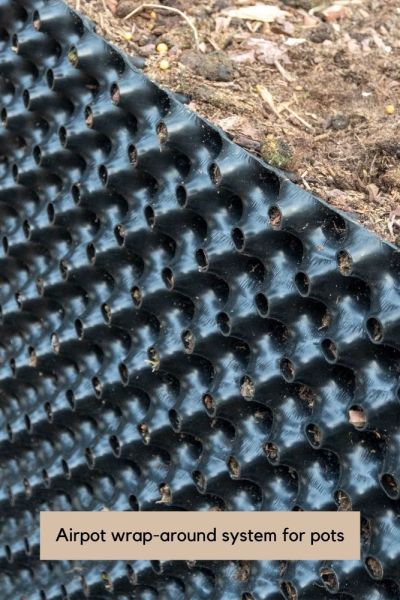
Made of recycled plastic, the Airpot re-usable potting system makes it easier to re-pot very large trees and shrubs.
Turn a large tree into a small tree with pruning and shaping
There are several ways of pruning trees to control their size and shape. Not all trees can be shaped in the same ways.
Jamie lists ‘boxhead’ shapes, pollarded, pleached, espaliered, ‘table top’ and topiarised trees as good options for small gardens. However, you will have to maintain the shapes. That usually means annual trimming, so that needs to be factored in.
Pollarding trees to reduce their height
Pollarding means cutting off the branches around the crown of the tree, often every year. It keeps trees smaller than they would usually grow. There are limes in my street which are pollarded every two to three years. Pollarding keeps the height under control. With time, the trunks get thick and gnarly.
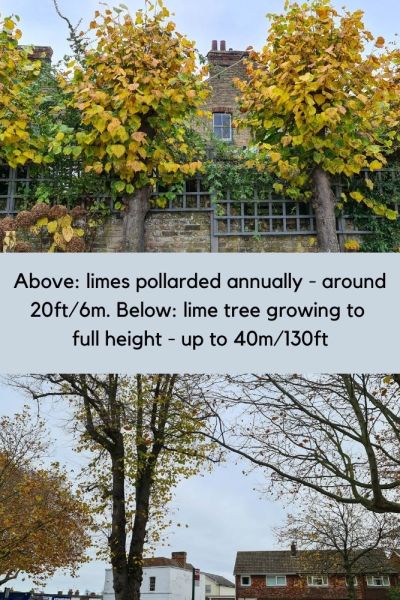
The pollarded lime trees at the top are in Jane Beedle’s garden. She trims all the branches off every winter, which keeps the height to around 20ft. She originally thought that was still too big for her 52ft long garden, but now says they’re an ideal size to offer privacy and some shade, but not blocking the light. See more of Jane’s contemporary town garden here.
At Form Plants, there are lots of beautifully gnarled olive trees that have been regularly pollarded. Olive trees can grow to 25ft-30ft, but when pollarded they can be around 6ft-10ft.
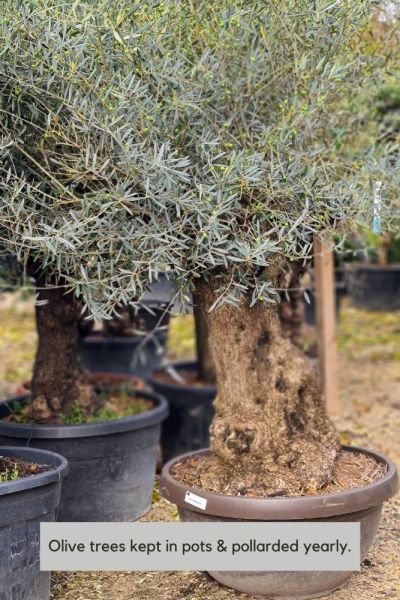
Olive trees grow to around 30ft/10m and are not very hardy. They can be damaged by frost, especially if temperatures go below minus 10C/14F. But they are good trees for small, sheltered urban gardens and can be kept small by pollarding.
You can pollard limes (Tilia not citrus), olives, hornbeam, oak, willow and poplar as well as some other trees.
Pleached or espaliered trees for small gardens
Pleaching trees means training the branches on a framework and linking them together. Pleaching is often called ‘a hedge on stilts’, as the trees are cut in a geometric shape and can seem almost two dimensional.
Espaliered trees are also grown on a framework, sometimes against a wall. It’s used in fruit growing so that the fruit is exposed to the sun, rather than being covered by branches.
Pleached and espaliered trees take up much less space, but they need pruning once or twice a year to keep them in shape. This way of shaping trees is often used to create privacy in urban gardens because it can block a view without blocking too much light. This post has more tips on choosing trees for privacy.
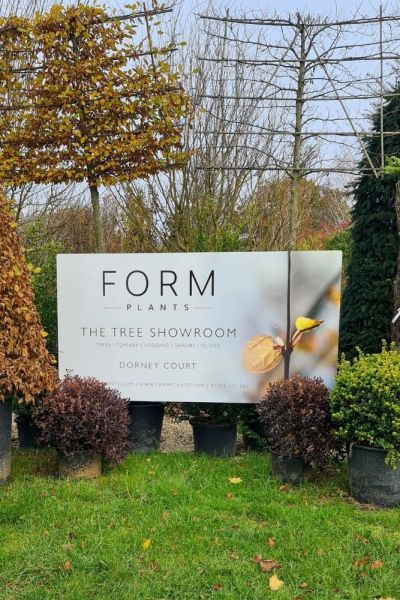
These trees on frames by the entrance to Form Plants await their next destination. The frames can create a continuous ‘hedge on stilts’, an effect often used for beech or hornbeam, which would otherwise be too large for small gardens.
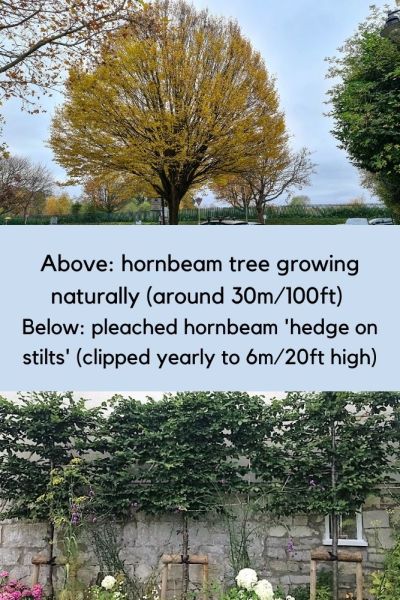
Hornbeams are amongst the largest street trees, but they can be pleached on frames and clipped annually to keep them compact.
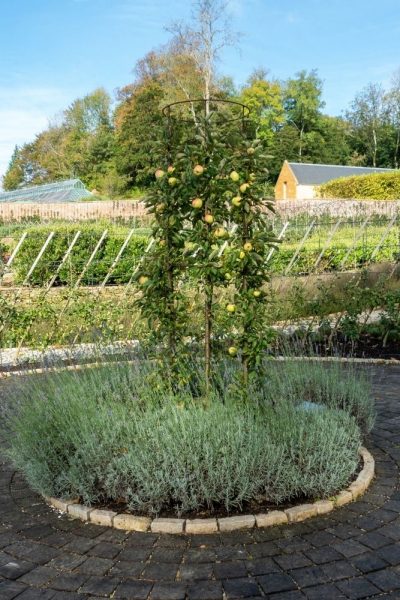
These fruit trees are trained to frames at The Newt in Somerset, where the gardens have a huge range of pleached and espaliered fruit trees in lots of shapes and styles. You can see some of the espaliered trees behind it.
Training fruit trees onto different espalier shapes means you can grow a surprising amount of fruit in a small garden. There’s even a small urban garden which has 80-100 espaliered apple and pear trees in a space around 80ft long. Read about it in ‘you can have an orchard in a small garden.’
‘Table top’ and ‘box’ pruned trees
These are two shapes currently trending in contemporary garden design. They’re done with trees that can be pleached – hornbeam, lime (Tilia, not the citrus tree), London plane, beech and more.
‘Table top’ trees are so contemporary that you can barely even Google them. When I searched, the results included lots of little trees you could have inside on your dining table.
But these ‘table top’ are proper trees, also grown on a frame. At Form Plants, they have them grown from London plane, which would normally be far too big for a small garden.
A ‘table top’ shape has a single upright trunk, free of all branches. And the crown is grown on a flat frame to create a ‘table top’ effect. You can see ‘table top’ trees in one of the gardens created by Polly Wilkinson in this post on how to design a garden.
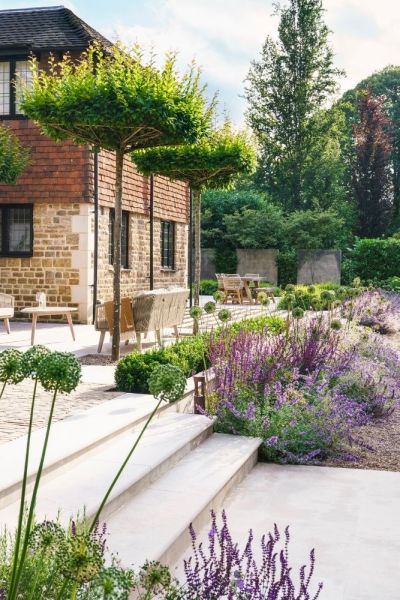
‘Table top’ trees in a garden designed by Pollyanna Wilkinson Garden Design. From a photo by Rae Warren.
Topiarise your trees to keep them small
‘Box’ pruned trees are literally trees with their canopy pruned square, in the shape of a box. They look very smart, too. They’re a contemporary shape for a topiarised tree.
Topiarising is cutting the tree into shapes. I’ve got several topiarised trees in my garden. Two are holm oaks, which could grow to 80ft/20m high if I didn’t have them trimmed into double pom-poms every year. We also have a large holly ‘Golden King’, trimmed into a wedding cake shape. It was originally a lump of a shrub.
You can buy topiarised trees, but they are often expensive. If you topiarise your trees yourself, then it will usually take a few years for them to reach the ideal shape. And if you are keeping them tree-sized, you may need to pay an expert to do the cutting.
Multi-stemmed and coppiced trees
Multi-stemmed trees are also increasingly popular now. They’re a great way of reducing the size of a large tree, such as silver birch or limes to fit them into a smaller garden. To create a multi-stemmed tree, the RHS says you cut the main stem off a young tree and allow several stems to re-grow from the base.
Not all trees will re-grow when cut hard back at the base, but good ones to try include hazel, lime (Tilia), dogwoods, beech, yew, elder, hornbeam and cotinus. I’ve also known people to multi-stem silver birches and amelanchiers. It may be more reliable to buy your tree multi-stemmed to start with.
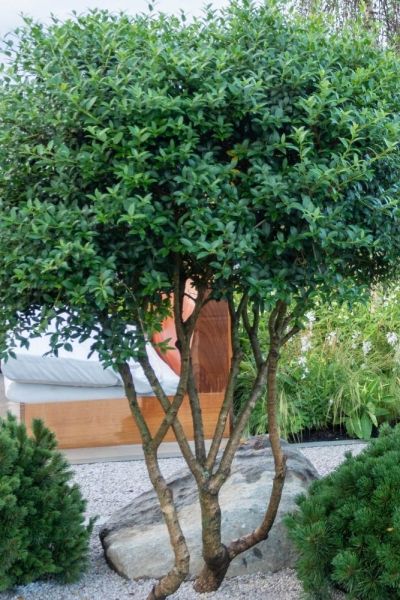
Multi-stemmed Osmanthus x burkwoodii , a small evergreen tree or shrub that adapts beautifully to a multi-stem shape for a small garden.
One of Jamie’s favourite multi-stemmed trees is Osmanthus burkwoodii.
You may already have the best tree for your small garden
If you already have a tree in your garden, but you feel it’s too big, don’t automatically think about replacing it.
Jamie says that it’s far better to prune a tree than cut it down. ‘I don’t mean go at it as if it was a Tesco car park,’ he says. Although tree pruning should be done by expert, it’s worth thinking about what sort of pruning you’d like. This post on how to prune for privacy and light, for example, shows a way of pruning that keeps the shape of the tree but allows more light through.
Or you could consider one of the shapes above.
Either way, always put safety first when pruning trees. There are more serious gardening accidents around tree work than any other activity, which is why I’d suggest calling in an arborist or a tree surgeon. But be aware that not everyone with a chainsaw is qualified or knowledgeable enough to shape your tree properly. That’s why I wrote this post on finding an arborist, tree surgeon or chainsaw man.
Jamie’s pick of trees for small gardens
The absolute best tree will vary according to your garden, weather and design. But check out some of these more unusual trees, which Jamie recommends for small gardens.
- Acer griseum (Paperbark maple)
- Several types of cherry (Prunus)
- Osmanthus x burkwoodii
- Koelreuteria paniculata (Pride of India tree)
- The cornus family (dogwoods)
- Heptacodium micinoides (Seven sons tree)
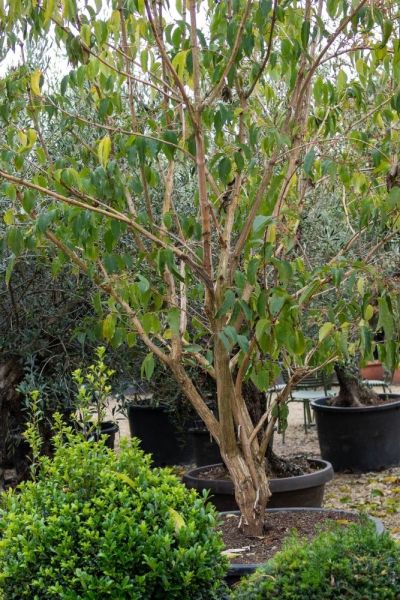
Seven Sons Tree (Heptacodium micinoides) is a small elegantly shaped tree with pretty autumn flowers and attractive peeling bark. (13-30ft/4m-9m)
It’s essential to plant your trees properly
Planting a tree is easy, but there are a few tips you need to know. You must plant it at the right depth, you must secure it with a stake and tie and you need to remove that stake and tie after 1-2 years. And it’s essential to water newly planted trees regularly.
See this post for Jamie’s advice on how to plant a tree.
Good books about trees and gardening
Jamie’s book RHS 50 Plants You Can’t Kill is an ideal guide for beginner gardeners. It covers 50 easy-to-grow indoor and outdoor plants, listing what the plants need, plus other useful expert tips.
One of the most popular books on the Middlesized Garden Amazon store is Alan Titchmarsh’s How to Garden: Small Trees. As well as basic advice on choosing and pruning trees, it also lists trees for ‘challenging sites’. This includes trees for tiny gardens, windy gardens, dry gardens and more.
And if you’re looking for trees for privacy, the Middlesized Garden’s own Complete Guide to Garden Privacy gives you a range of privacy options, including trees, screening, pergolas, fences and hedges.
Note that links to Amazon are affiliate, see disclosure.
Pin to remember choosing trees for small gardens
And do join us for a free weekly email with more tips, ideas and inspiration for your garden.
